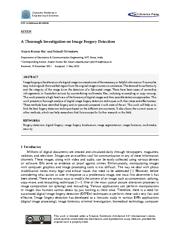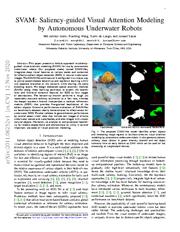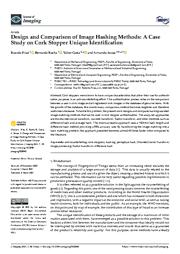A copy of this work was available on the public web and has been preserved in the Wayback Machine. The capture dates from 2021; you can also visit the original URL.
The file type is application/pdf.
Filters
Pedestrian Detection Using Quaternion Gradient Based Weber Local Descriptor
2021
IEEE Access
Firstly, the quaternion gradient representation is performed on the color image in the sliding window, and then the Weber Local Descriptor (WLD) is extracted over the quaternion gradient feature map. ...
INDEX TERMS Pedestrian detection, quaternion gradient, Weber local descriptor, video surveillance. ...
a quaternion gradient based Weber local descriptor (QGWLD) is constructed for pedestrian detection in a color image. ...
doi:10.1109/access.2021.3063294
fatcat:y56rfnyn2fdwdgeugojfx3owji
Saliency Detection via Combining Global Shape and Local Cue Estimation
[chapter]
2017
Lecture Notes in Computer Science
Firstly, Quaternionic Distance Based Weber Descriptor (QDWD), which was initially designed for detecting outliers in color images, is used to model the salient object shape in an image. ...
In this paper, a novel framework for image saliency detection is introduced by modeling global shape and local cue estimation simultaneously. ...
Quaternionic Distance Based Weber Descriptor The global methods [16, 29, 30] , which are characterized by holistic rarity and uniqueness, take the entire image information into consideration to detect ...
doi:10.1007/978-3-319-67777-4_28
fatcat:uxlgclm4ovbwlefjnf5usuz7la
A Quaternionic Wavelet Transform-based Approach for Object Recognition
English
2014
Defence Science Journal
English
In this paper a method to recognize objects from different categories of images using quaternionic wavelet transform (QWT) is presented. ...
Hence to identify local features and certain region of images, patches are extracted over the interest points detected from the original image using Wavelet based interest point detector. ...
Raphael Soulard, XlIM-SIc laboratory, university of Poitiers, france for his support in implementing the algorithm of QWT. ...
doi:10.14429/dsj.64.4503
fatcat:sm7csncdljh3jgqwvgzx76v4jm
Perceptual Image Hashing Based on Weber Local Binary Pattern and Color Angle Representation
2019
IEEE Access
The main contribution of this paper is a novel construction for image hashing that incorporates texture and color features by using Weber local binary pattern and color angular pattern. ...
INDEX TERMS Image hashing, Weber's law, local binary pattern, color angular pattern. 45460 2169-3536 ...
Compared with the traditional local binary pattern (LBP) method, a texture image obtained using a Weber local binary pattern (WLBP) is less affected by noise. ...
doi:10.1109/access.2019.2908029
fatcat:4fehjmqr45gi7cs6gmfp32kk3u
Saliency detection based on directional patches extraction and principal local color contrast
2018
Journal of Visual Communication and Image Representation
Meanwhile, we proposed an efficient local color contrast method, called principal local color contrast (PLCC), to compute the color contrast between the salient object and the image background, which is ...
In this paper, we propose a novel computational model for saliency detection by integrating the holistic centerdirectional map with the principal local color contrast (PLCC) map. ...
[34] proposed a saliency detection method by combining quaternionic distance based weber local descriptor and low-level priors. ...
doi:10.1016/j.jvcir.2018.10.008
fatcat:nndomtfxgjc2nanklt7pqbsxiq
Saliency Detection Using Texture and Local Cues
[chapter]
2017
Communications in Computer and Information Science
consideration to guarantee the accuracy of the detected salient regions. ...
Then, we detect local saliency by using a locality-constrained linear coding algorithm. Finally, the output saliency map is computed by integrating texture and local saliency cues simultaneously. ...
Recently, a bottom-up saliency-detection method by integrating Quaternionic Distance Based Weber Descriptor (QDWD), center and color cues, was presented in [25] . ...
doi:10.1007/978-981-10-7305-2_58
fatcat:cxbb5skvmrgsvlbc364d3za3o4
The extended marine underwater environment database and baseline evaluations
2019
Applied Soft Computing
This database is called the Marine Underwater Environment Database (MUED), which contains 8600 underwater images of 430 individual groups of conspicuous objects with complex backgrounds, multiple salient ...
The publicly available MUED provides researchers in relevant industrial and academic fields with underwater images under different types of variations. ...
[41] by integrating the Quaternionic Distance Based Weber Descriptor and pattern distinctness with local contrast to estimate the underwater image saliency. ...
doi:10.1016/j.asoc.2019.04.025
fatcat:pfj5ze72jrcvhdnqrp5li2sbny
A Thorough Investigation on Image Forgery Detection
2023
CMES - Computer Modeling in Engineering & Sciences
Image forging is the alteration of a digital image to conceal some of the necessary or helpful information. ...
The demand for authenticity and the integrity of the image drive the detection of a fabricated image. ...
The WLDs (Weber Local Descriptors) computed and extracted feature from each super pixel is then presented. ...
doi:10.32604/cmes.2022.020920
fatcat:u7bvtghwlvadvcaw62ay5ywm3e
The Use of Saliency in Underwater Computer Vision: A Review
2020
Remote Sensing
Underwater survey and inspection are tasks of paramount relevance for a variety of applications. ...
Visual saliency refers to the computational modeling of the preliminary perceptual stages of human vision, where the presence of conspicuous targets within a surveyed scene activates neurons of the visual ...
The normalized directional features are then fused to form an integrated directional map referred to as Quaternionic Distance Based Weber Descriptor (QDWB). ...
doi:10.3390/rs13010022
fatcat:7i6r2jftdvdtzepcecm56pqqhi
Survey on Local Color Image Descriptors
International Research Journal of Engineering and Technology (IRJET)
unpublished
Color characteristics can be included using the Quaternionic representation. A detailed study in the field of local descriptors and Quaternionic representation has been done. ...
Image descriptor is an important topic in the field of image processing. Image descriptors are used to have the characteristics of an image. ...
Main contributions of the experiments are as follows: For color image feature extraction, the system proposes the Quaternionic Weber Local Descriptor (QWLD) framework. ...
fatcat:s5ceurkrpjcqxk2okgtjezaet4
SVAM: Saliency-guided Visual Attention Modeling by Autonomous Underwater Robots
[article]
2022
arXiv
pre-print
We also validate its generalization performance by several ocean trials' data that include test images of diverse underwater scenes and waterbodies, and also images with unseen natural objects. ...
of the salient objects. ...
Distance-based Weber Descriptor (QDWD) [35] , (ii) saliency estimation by the Segmentation of Underwater IMagery Network (SUIM-Net) [13] , (iii) saliency prediction by the Deep Simultaneous Enhancement ...
arXiv:2011.06252v2
fatcat:crctlr7i5jcqbdafbejg5ix7l4
Visual Saliency Detection Based on color Frequency Features under Bayesian framework
2018
KSII Transactions on Internet and Information Systems
In this paper, a bottom up saliency detection model is proposed by taking into account the color and luminance frequency features of RGB, CIE L*a*b* color space of the image. ...
We employ low-level features of image and apply band pass filter to estimate and highlight salient region. We compute the likelihood probability by applying Bayesian framework at pixels. ...
Firstly, edges and outliers are detected using Quaternionic Distance Based Weber Descriptor. Secondly, center prior and than color prior cues are used to estimate the salient object. ...
doi:10.3837/tiis.2018.02.008
fatcat:qm7obburwbbcrjxszy34sxo7qa
Semi-supervised Cross-media Feature Learning via Efficient L2,q Norm
2019
KSII Transactions on Internet and Information Systems
In our method, noise and edge information have less effect on the results of cross-media retrieval and the dynamic patch information of multimedia data is employed to increase the accuracy of cross-media ...
In this paper, we propose a semi-supervised method for cross-media feature learning by means of L 2,q norm to improve the performance of cross-media retrieval, which is more robust and efficient than the ...
In the aspect of feature learning, Jian et al. [28] exploit Quaternionic Distance Based Weber Descriptor for detecting outliers in color image and apply hierarchical scheme for object detection. ...
doi:10.3837/tiis.2019.03.016
fatcat:wrpevsytjfamzljj3aslx2agaq
Design and Comparison of Image Hashing Methods: A Case Study on Cork Stopper Unique Identification
2021
Journal of Imaging
This authentication process relies on the comparison between a user's cork image and all registered cork images in the database of genuine items. ...
With the growth of the database, this one-to-many comparison method becomes lengthier and therefore usefulness decreases. ...
Conflicts of Interest: The authors declare no conflict of interest. ...
doi:10.3390/jimaging7030048
pmid:34460704
pmcid:PMC8321315
fatcat:uqkphjs6c5bj3ppwyscdeah36u
One-shot learning and generation of dexterous grasps for novel objects
2015
The international journal of robotics research
The first type is a contact model and is a density over the pose of a single hand link relative to the local object surface. ...
The learned model is a product of experts, in which experts are of two types. ...
local minima. ...
doi:10.1177/0278364915594244
fatcat:tl7pl2jmrncg3asqeow7x2dika
« Previous
Showing results 1 — 15 out of 63 results















